
Prime Heritage
About Prime Heritage
Prime Wood was founded in 1930 by a young, dedicated Italian-American business man named Ceasare Tuccinardi. Ceasare started out primarily handcrafting quality furnitire, and was very succesful in making custom breakfast nooks. Shorly after launching his business, Ceasare had his three boys Phil, Louie and Lorrie, and it wasn’t long before Prime became a family affair.
By 1964 the company had began curving plywood for some of its furniture projects. The presses the Tuccinardi family hand built for this process would eventually produce some of the earliest “kick tail” skateboards. With the new presses in place, Prime began pressing wood for early skateboard brands like Madrid and Z Products (Z Boys). The first skateboards were pressed by Prime Wood in 1968, making Prime one of the earliest mass producers of skateboards.
By 1988, Professional skateboarders Steve Rocco and Rodney Mullen felt the industry shifting, and left Sims and Powell respectively to found World Industries. The two walked through the Prime doors shortly after, and worked closely with Phil Tuccinardi to perfect the modern day skateboard. To this day Phil speaks of the countless hours Rodney spent shaping and perfecting things at the Prime factory to make top notch, quality skateboards. It was during this time Prime began making skateboards for almost the entire industry, and had a production roster that included brands like World, Blind, Plan B, 101, Shorty’s, Birdhouse,
Flip, Hookups, Baker, and the Firm to name just a portion. Prime Wood at it's peak had 220 employees, produced 2.4 million skateboards a year, and was running 24 hours a day, 7 days week.
Phil, Louie and Lorrie all retired in 2008 and sold the Prime business to longtime skateboarder and musician Scott Holloway. Scott has since relocated the USA production facility to South Pasadena in Los Angeles County. Today each and every employee at Prime is also a passionate skateboarder, which ensures that our skateboards are made by individuals who really care about the quality of our products. The managerial staff now includes skateboarders and industry experts Jacob Tillman, who is now a partner in the company and whole heartedly oversees all skateboard production, and 25 year industry veteran and longtime professional skateboarder Chris Pastras, who is Prime's Brand Manager.
We at Prime firmly root ourselves in our love for skateboarding, and believe our dedication bleeds into every skateboard product produced at Prime Wood. We proudly produce a full range of products, including 100% handcrafted quality skateboards, proudly made by skateboarders right here in Los Angeles.
Skateboard Decks Specs
- Deck width: 7.6" and larger
- Ages 13 years old and older
- Skater height 5'3" and taller
- Size 9 shoes or larger
Skateboard Completes Specs
- Deck width: 7.6" and larger
- Ages 13 years old and older
- Skater height 5'3" and taller
- Size 9 shoes or larger
Micro Decks Specs
- Deck width: 6.75" or smaller
- Ages 5 years old or younger
- Skater height 3'4" and under
- Size 3 shoes or smaller
Mini Decks Specs
- Deck width: 7.0"
- Ages 6 to 8 years old
- Skater height between 3'5" & 4'4" tall
- Size 4-6 shoes
Mid Decks Specs
- Deck width: 7.3" - 7.6"
- Ages 9 to 14 years old
- Skater height between 4'5" & 5'2" tall
- Size 7-8 shoes
Micro Completes Specs
- Deck width: 6.75" or smaller
- Ages 5 years old or younger
- Skater height 3'4" and under
- Size 3 shoes or smaller
Mini Completes Specs
- Deck width: 7.0"
- Ages 6 to 8 years old
- Skater height between 3'5" & 4'4" tall
- Size 4-6 shoes
Mid Completes Specs
- Deck width: 7.3" - 7.6"
- Ages 9 to 14 years old
- Skater height between 4'5" & 5'2" tall
- Size 7-8 shoes
Let Us Grip Tape Your Board
Don’t feel comfortable gripping up your new board? No need to worry. Avoid uneven lines and unwanted air bubbles by letting our professionals grip your new deck for you.
Let Us Build Your Skateboard
Do you want Warehouse Skateboards to Assemble your Complete Skateboard?
This service includes:
- Professionally gripping the skateboard deck. Insuring no bubbles and a nice clean cut around the edge.
- Pressing 8 skateboard bearings into 4 wheels. Each bearing will be seated with a professional bearing press and will include bearing spacers when necessary.
- Assembly of skateboard trucks and wheels. Both truck assemblies will have wheels installed with proper speed washers and torqued to the appropriate tolerance.
- Installing both truck assemblies to the gripped deck and assuring proper torque tolerance on all hardware.
- An autographed Warehouse Skateboards hang tag from your builder.
Skateboard Hardware Sets
Skateboard hardware is used to connect the skateboard trucks to the skateboard deck. Skateboard hardware refers to the bolts and locknuts used when building a board. The bolts can have an Allen or Phillips head. Skateboard hardware comes in many different lengths, and often includes one different colored bolt so that the rider can mark the nose of their board.
Each skateboard hardware set includes 8 bolts and 8 locknuts needed to assemble one skateboard.
What size hardware do I need to put together my skateboard?
- 7/8" to 1" hardware - no riser
- 1" to 1 1/8" hardware - 1/8" riser
- 1 1/4" hardware - 1/4" riser
- 1 1/2" hardware - 1/2" riser
The width of your truck axle should closely match the width of your skateboard deck, usually within 1/4”.
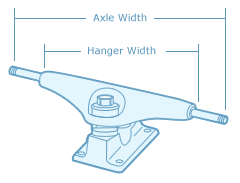
For additional info visit our
Skateboard Trucks Buying Guide
Truck height is measured from the bottom of the truck’s baseplate to the center of the axle. In general, a mid-sized truck works well for most skateboarders, but high or low trucks may be preferred for different styles of skaters.
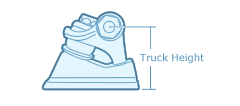
LO - Provides extra stability for flip tricks, designed for small wheels (50-53mm wheel size recommended).
MID - Good all-around profile for street or park (53-56mm wheel size recommended).
HIGH - Great for cruising and carving, designed for large wheels (56mm+ wheel size recommended).
For additional info visit our
Skateboard Trucks Buying Guide
The hanger is the truck's T-shaped aluminum alloy grind area. It makes direct contact with rails and curbs. The hanger holds the axle on which the wheels are mounted. Hangers weigh about 10-13 oz, with lighter ones available. The width of your truck axle should closely match the width of your skateboard deck, usually within 1/4”.

For additional info visit our
Skateboard Trucks Buying Guide
Construction refers to the material(s) used in fabrication or the specific brand technology.
For additional info visit our
Skateboard Buying Guide
The average width of a skateboard deck is 7.5"- 8.25". Width is influenced by the size of the rider and the type of riding. Bigger riders and those skating ramps typically prefer a wider deck. Street skaters usually choose a smaller deck. Choose your skateboard deck according to the width, not length. Here are some general guidelines:
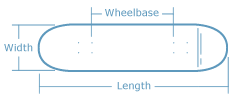
MICRO - Deck width: 6.75" or smaller - 5 years old or younger, under 3'4" tall. Size 3 shoes or smaller.
MINI - Deck width: 7.0" - 6 to 8 years old between 3'5" & 4'4" tall. Size 4-6 shoes.
MID - Deck width: 7.3" - 9 to 12 years old between 4'5" & 5'2" tall. Size 7-8 shoes.
FULL - Deck width: 7.5" or larger - for all skaters over age 13, taller than 5'3" with a shoe size of 9 or up.
7.5" to 8"
Standard board for adult riders skating streets or doing more technical tricks
8.0" to 8.25"
Skating pools, ramps and parks
8.25" and larger
Vert, pools, cruising and just going old school
Still having a hard time with size, try our Skateboard Sizer
For additional info visit our
Skateboard Decks Buying Guide
Deck type refers to the size or style (shape) of the skateboard deck. If you are a beginner, choose your deck according to the width, not the length. The width you need depends on your size, skating style and personal preference. Here are some general guidelines:

MICRO - Deck width: 6.75" or smaller - 5 years old or younger, under 3'4" tall. Size 3 shoes or smaller.
MINI - Deck width: 7.0" - 6 to 8 years old between 3'5" & 4'4" tall. Size 4-6 shoes.
MID - Deck width: 7.3" - 9 to 12 years old between 4'5" & 5'2" tall. Size 7-8 shoes.
FULL - Deck width: 7.5" or larger - for all skaters over age 13, taller than 5'3" with a shoe size of 9 or up.
Cruisers, Old School, Freestyle, Longboard and Downhill all refer to a skateboarding style and the corresponding shape.
For additional info visit our
Skateboard Decks Buying Guide
Length is measured from the tip of the nose to the tip of the tail. Average board length is 28"- 32" and longboards can range 32" and larger, but length is only referred to by advanced skaters.

For additional info visit our
Skateboard Decks Buying Guide
Wheel size or diameter - All Skateboard wheels are measured in millimeters (mm). The smaller the number, the smaller the wheel. Smaller wheels are slower; bigger wheels are faster.
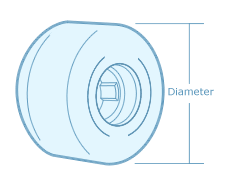
50-53mm - Small slower wheels, stable for trick riding and smaller riders skating street, skate parks and bowls.
54-59mm - Average wheel size for beginners and bigger riders skating street, skate parks, bowls and vert ramps.
60mm + - Specialty riders skating longboards, old-school boards, downhill and dirt boards; made for speed and rougher surfaces.
For additional info visit our
Skateboard Wheels Buying Guide
Durometer measures the wheel’s hardness. Harder wheels are faster; softer wheels are slower but have better grip.
78a-87a - Soft wheel good for rough surfaces, longboards or street boards that need lots of grip and easier to roll over cracks and pebbles. Designed for a smooth ride cruising, longboards, hills and rough surfaces.
88a-95a - Slightly harder and faster with a little less grip, but the grip's still good. Street; rough surfaces.
96a-99a - Good speed and grip - an all-around wheel. Great for beginners skating street, skate parks, ramps and pools. Smooth surfaces.
101a + - Hardest and fastest wheel with the least grip. Ineffective on slick and rough surfaces. These are pro wheels.
83b-84b - Wheels using the B scale are extremely hard, measuring 20 points lower than the the A Scale in order to allow the scale to extend another 20 points for harder wheels.
For additional info visit our
Skateboard Wheels Buying Guide
The laws for skateboarding helmets vary from state to state. Many states require that skaters wear a helmet under a certain age, and some states like California make all skaters under 18 wear a CPSC Certified helmet at all times. CSPC skateboard helmets usually have an EPS protective liner that meets the safety standards for skateboarding. Make sure you check your state's regulations before ordering.
CPSC Certified Helmets: California requires that all skateboard helmets must meet the requirements of the United States Consumer Product Safety Commission (CPSC). Section 890.4 of the Streets and Highways Code enforces these standards in California and will not allow Warehouse Skateboards to ship non-CPSC Certified helmets to California.
For additional info visit our
Skateboard Helmets Guide
Unsure of the size you need?
Visit our Clothing Sizing Charts
Note: Each brands skateboard helmet size will vary; therefore, it is best to measure your head and refer to the sizing chart specific to each brand of helmet. In order to properly measure your head, follow these steps:
Wrap a soft tape measure around your forehead, just above your eyebrows and ears. Keep the tape measure level from the front to the back of your head. Your skateboard helmet should sit low on your forehead.
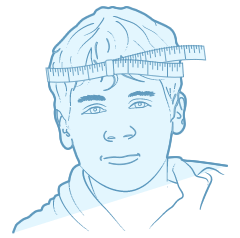
If you do not have a flexible tape measure, try marking a string and measuring it against a ruler.
If the helmet is a gift or you cannot measure the skater's head, measure the inside of a current helmet or hat they wear.
Within each skateboard helmet product page there are specific measurements for each skate brand. Use that information, along with your head size, to determine your correct helmet size before placing your order. This will ensure that you receive the best fit.
For additional info visit our
Sizing Skateboard Helmets